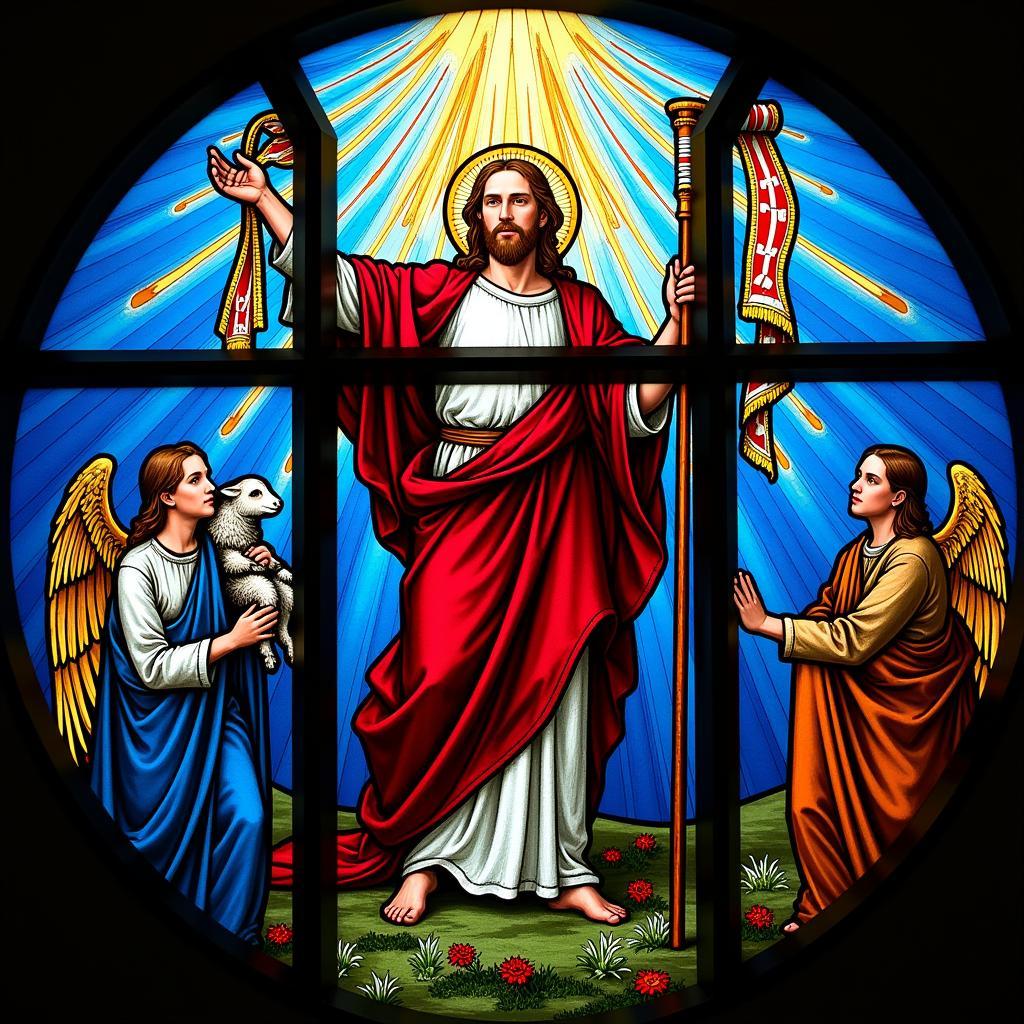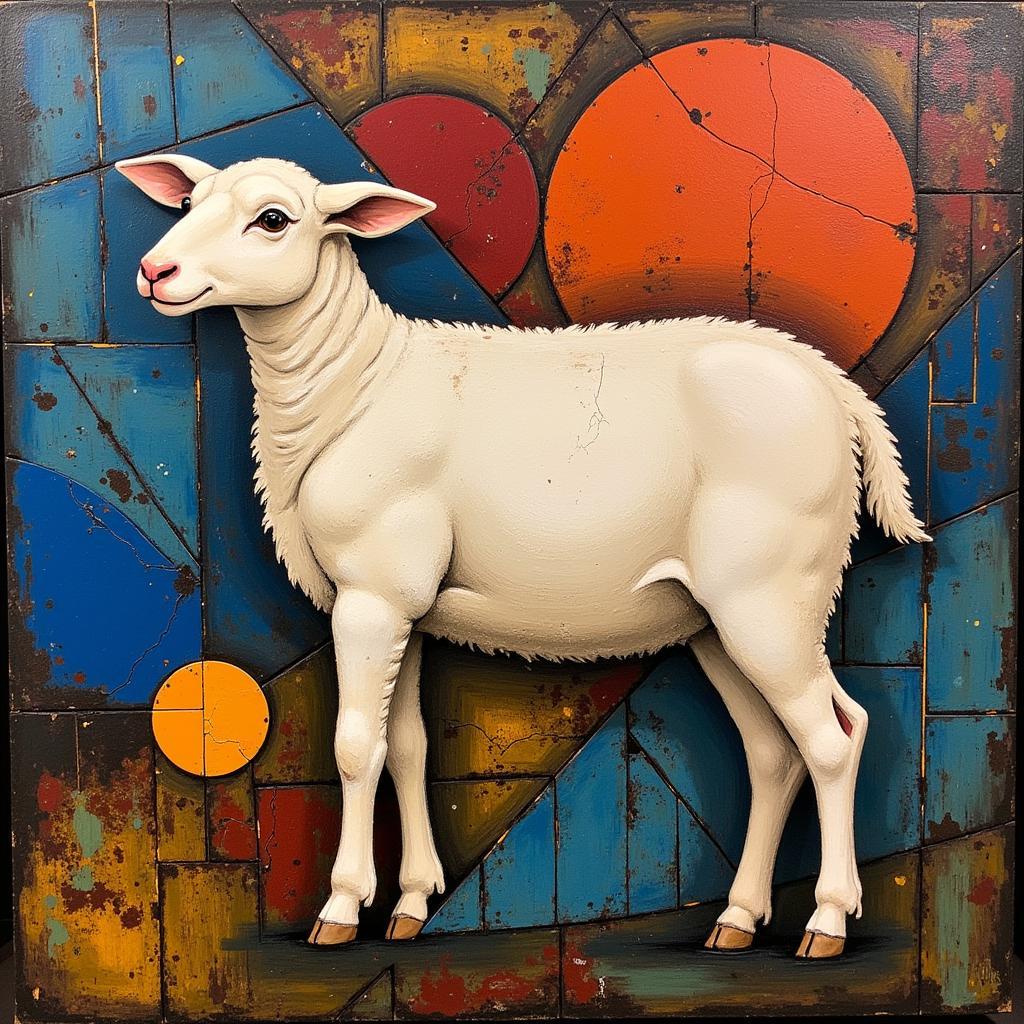Exploring the Divine: Lamb of God Art Through the Ages
Lamb Of God Art, a powerful symbol of sacrifice and redemption, has captivated artists and viewers for centuries. From the catacombs of Rome to the grand cathedrals of Europe and beyond, the image of the lamb, often carrying a banner or a cross, has resonated deeply within religious and artistic contexts. This exploration delves into the fascinating history, symbolism, and diverse interpretations of this enduring motif.
The Symbolism of the Lamb in Art
The lamb’s significance stems primarily from Christian theology, where it represents Jesus Christ, the “Lamb of God” who takes away the sins of the world. This symbolism is rooted in the Old Testament Passover, where a lamb was sacrificed to protect the Israelites from the Angel of Death. The connection is further reinforced in the New Testament, specifically in the Book of Revelation, where Christ is referred to as the Lamb. This powerful imagery has imbued the lamb with a rich tapestry of meanings, representing innocence, purity, gentleness, and ultimately, sacrifice. Renaissance art symbols often included the lamb, further solidifying its presence in Western artistic traditions.
After this introductory look at the symbolism of the lamb in art, let’s delve into the historical evolution of this powerful image.
The Historical Evolution of Lamb of God Art
From early Christian art’s simple representations in the catacombs to the elaborate depictions found in Renaissance paintings and sculptures, the Lamb of God has undergone a fascinating evolution. Early depictions focused on simplicity, often showing a lamb with a halo and a cross. As Christianity gained prominence, the imagery became more sophisticated, incorporating elements like the banner of victory, the chalice, and the book of life. The Lamb of God has not only been a central theme in religious art, but it has also found its place in secular art, often appearing in allegorical and symbolic contexts. Jesus art work frequently features the lamb, showcasing the profound impact of this symbol on Christian iconography.
Lamb of God Art in Different Mediums
The Lamb of God motif isn’t confined to a single medium. It has been expressed through various artistic forms, including painting, sculpture, mosaic, illuminated manuscripts, and even stained glass. Each medium lends a unique dimension to the image. The vibrant colors of stained glass illuminate the lamb’s divine nature, while the intricate details of illuminated manuscripts emphasize its symbolic importance. Sculptures, on the other hand, give the lamb a tangible presence, inviting viewers to contemplate its profound sacrifice.
Why is the Lamb of God a Popular Subject in Art?
The enduring popularity of the Lamb of God as a subject in art lies in its profound symbolic resonance. It encapsulates complex theological concepts in a visually arresting and emotionally evocative image. The lamb’s inherent gentleness and innocence contrast sharply with the idea of sacrifice, creating a powerful juxtaposition that highlights the magnitude of Christ’s sacrifice. This contrast makes the Lamb of God a compelling subject for artists seeking to explore themes of redemption, faith, and the divine.
 Lamb of God Stained Glass Window
Lamb of God Stained Glass Window
What Does the Banner in Lamb of God Art Represent?
The banner often depicted in Lamb of God art typically represents Christ’s victory over death and sin. It often features a cross, symbolizing the instrument of his sacrifice and his subsequent triumph. The banner serves as a powerful reminder of the hope and redemption offered through Christ’s sacrifice.
How has the depiction of the Lamb of God changed over time?
Over time, the depiction of the Lamb of God has evolved from simple, almost naive representations to more complex and elaborate portrayals. Early depictions emphasized the lamb’s innocence and sacrificial nature. Later depictions often incorporate more symbolic elements, such as the banner of victory, the chalice, and the book of life, reflecting a deeper theological understanding.
 Lamb of God Modern Interpretation
Lamb of God Modern Interpretation
Conclusion
Lamb of God art offers a fascinating journey through the intersection of faith, art, and history. It demonstrates the enduring power of symbols to convey complex ideas and evoke deep emotions. From ancient mosaics to modern interpretations, the Lamb of God continues to inspire and challenge, reminding us of the enduring message of sacrifice, redemption, and hope.
FAQ
- What does the Lamb of God symbolize? The Lamb of God symbolizes Jesus Christ and his sacrifice for humanity’s sins.
- Where does the symbolism of the Lamb of God come from? The symbolism originates from the Old Testament Passover and is reinforced in the New Testament.
- What are some common elements found in Lamb of God art? Common elements include a halo, a cross, a banner, a chalice, and the book of life.
- In what mediums is Lamb of God art typically found? It can be found in painting, sculpture, mosaic, illuminated manuscripts, and stained glass.
- Why is the Lamb of God a popular artistic subject? Its powerful symbolism resonates with viewers and allows artists to explore complex themes.
- What does the banner in Lamb of God art represent? It often represents Christ’s victory over death and sin.
- How has the portrayal of the Lamb of God evolved over time? It has shifted from simple depictions to more complex and symbolic portrayals.
Common Scenarios and Questions
- Scenario: A student researching religious symbolism in art. Question: What are the different interpretations of the Lamb of God in art history?
- Scenario: An art enthusiast browsing an online gallery. Question: What are some famous examples of Lamb of God artwork?
- Scenario: A theologian preparing a sermon. Question: How does the imagery of the Lamb of God contribute to our understanding of Christ’s sacrifice?
Further Exploration
Explore our other articles on religious symbolism and iconography for more insights into the world of art and faith.
Contact Us
For further assistance, please contact us:
Phone: 02462573573
Email: [email protected]
Address: Savico Megamall, 7-9 Đ. Nguyễn Văn Linh, Gia Thụy, Long Biên, Hà Nội 10000, Việt Nam.
We have a 24/7 customer support team.



